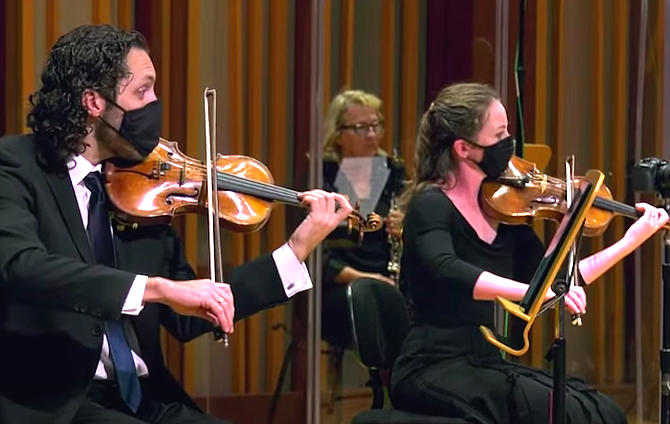 Facebook
Facebook
 X
X
 Instagram
Instagram
 TikTok
TikTok
 Youtube
Youtube

The end of October saw a flurry of live classical music and opera suddenly descend upon San Diego. October 24 was the conclusion of the Drive-In Mainly Mozart Festival and the opening of the Drive-In La Boheme by San Diego Opera. The previous day, Friday, October 23, was the first live San Diego Symphony concert in eight months.
The crowded line-up makes one wonder about the possibility of a little more cross-organizational communication. We had nothing for months and then everything at once followed by another stretch of nothing.
Fortunately, the San Diego Symphony concert is available for viewing on YouTube. The performance was recorded at The Conrad in La Jolla. The more intimate Conrad is a clear choice for this type of endeavor. Symphony Hall would have been a challenging venue.
The concert begins with a piece entitled Banner for Solo String Quartet and String Orchestra by Jessie Montgomery (b. 1981). Written in 2014, this is yet another forgettable piece of postmodernism. I’m sure there’s supposed to be an existential lesson in there somewhere but it failed to register with me.
This type of music feels as if it’s trying to state something instead of being something. Be a piece of music—first. If the music happens to make a statement, very well. There were promising sections of music that came and went leaving me wishing for a little, or a lot, more development of the musical material.
Mozart, Beethoven, Jessie Montgomery, George Walker
The next piece was quintessentially music. Mozart’s Divertimento in D Major was written in 1772 when he was but a lad of 16 years.
San Diego Symphony Music Director, Rafael Payare, conducted a socially distanced group of strings all playing on their own stands. The phrasing, so often a complaint of my when the symphony plays Mozart, was fantastic. Given the distance between the players, this is a feat worth applauding.
Hard on the heels of Mozart was Lyric for Strings from 1947 by George Walker. This piece was appropriately lyrical. I enjoyed discovering this piece by an American composer I had never heard before.
The final piece of the concert is Beethoven’s Triple Concerto. The soloists were all local talent of the highest order. Jeff Thayer, San Diego Symphony Concertmaster, played the violin solo, Alisia Weilerstein, played the cello solos, and Inon Barnatan was the pianist. This trio, conducted by Payare, could grace any stage in the world.
The orchestra was stripped down to just one player per part. The balances worked in the recorded version on YouTube. I’m not sure how this would have sounded live. All in all, this was a satisfying performance of a rarely performed piece. The soloists were spectacular individually and in ensemble.


The end of October saw a flurry of live classical music and opera suddenly descend upon San Diego. October 24 was the conclusion of the Drive-In Mainly Mozart Festival and the opening of the Drive-In La Boheme by San Diego Opera. The previous day, Friday, October 23, was the first live San Diego Symphony concert in eight months.
The crowded line-up makes one wonder about the possibility of a little more cross-organizational communication. We had nothing for months and then everything at once followed by another stretch of nothing.
Fortunately, the San Diego Symphony concert is available for viewing on YouTube. The performance was recorded at The Conrad in La Jolla. The more intimate Conrad is a clear choice for this type of endeavor. Symphony Hall would have been a challenging venue.
The concert begins with a piece entitled Banner for Solo String Quartet and String Orchestra by Jessie Montgomery (b. 1981). Written in 2014, this is yet another forgettable piece of postmodernism. I’m sure there’s supposed to be an existential lesson in there somewhere but it failed to register with me.
This type of music feels as if it’s trying to state something instead of being something. Be a piece of music—first. If the music happens to make a statement, very well. There were promising sections of music that came and went leaving me wishing for a little, or a lot, more development of the musical material.
Mozart, Beethoven, Jessie Montgomery, George Walker
The next piece was quintessentially music. Mozart’s Divertimento in D Major was written in 1772 when he was but a lad of 16 years.
San Diego Symphony Music Director, Rafael Payare, conducted a socially distanced group of strings all playing on their own stands. The phrasing, so often a complaint of my when the symphony plays Mozart, was fantastic. Given the distance between the players, this is a feat worth applauding.
Hard on the heels of Mozart was Lyric for Strings from 1947 by George Walker. This piece was appropriately lyrical. I enjoyed discovering this piece by an American composer I had never heard before.
The final piece of the concert is Beethoven’s Triple Concerto. The soloists were all local talent of the highest order. Jeff Thayer, San Diego Symphony Concertmaster, played the violin solo, Alisia Weilerstein, played the cello solos, and Inon Barnatan was the pianist. This trio, conducted by Payare, could grace any stage in the world.
The orchestra was stripped down to just one player per part. The balances worked in the recorded version on YouTube. I’m not sure how this would have sounded live. All in all, this was a satisfying performance of a rarely performed piece. The soloists were spectacular individually and in ensemble.
Comments